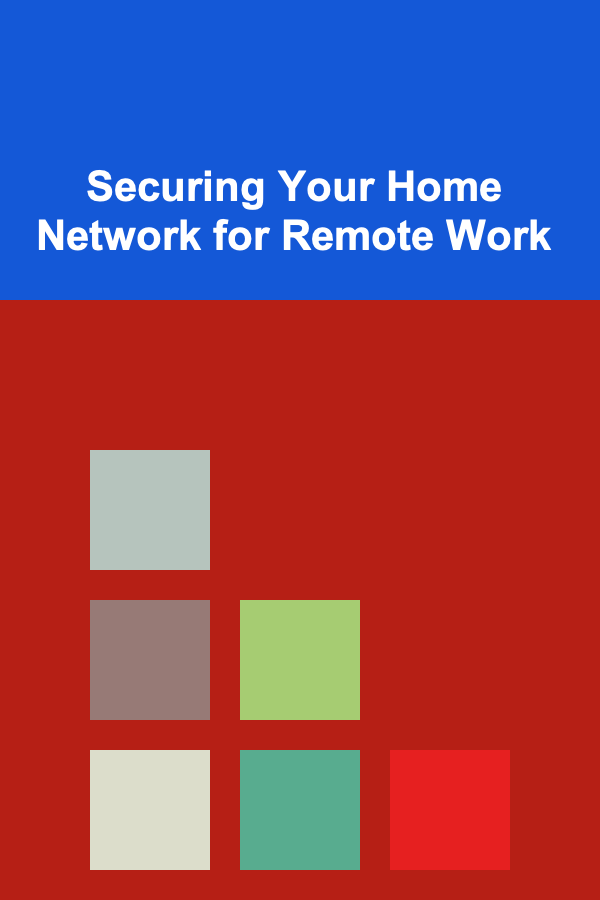
Securing Your Home Network for Remote Work
ebook include PDF & Audio bundle (Micro Guide)
$12.99$6.99
Limited Time Offer! Order within the next:

The rise of remote work has brought unprecedented flexibility and convenience. However, it has also introduced new security challenges. Your home network, once primarily used for personal activities, now carries the sensitive data of your employer. This makes it a prime target for cybercriminals. Securing your home network is no longer optional; it's a critical responsibility for protecting both your personal information and your company's assets. This article provides a comprehensive guide to bolstering your home network security for remote work, covering essential measures and best practices.
Understanding the Risks
Before diving into the solutions, it's crucial to understand the potential threats lurking within the digital landscape. Working remotely exposes your home network to several risks, including:
- Malware Infections: Viruses, worms, and trojans can infiltrate your network through infected websites, malicious email attachments, or compromised software.
- Phishing Attacks: Deceptive emails or messages can trick you into revealing sensitive information like passwords, financial details, or company credentials.
- Ransomware: This type of malware encrypts your data and demands a ransom payment for its release.
- Man-in-the-Middle Attacks: Hackers can intercept communication between your device and the internet, stealing sensitive data in transit. This is particularly concerning on unsecured public Wi-Fi.
- Weak Passwords: Easy-to-guess passwords make it simple for attackers to gain unauthorized access to your network and devices.
- Unsecured IoT Devices: Smart home devices like cameras, thermostats, and smart TVs can be vulnerable entry points for hackers if not properly secured.
- Outdated Software: Unpatched vulnerabilities in software and operating systems can be exploited by attackers.
- Social Engineering: Attackers may manipulate you into divulging confidential information or performing actions that compromise your security.
- Wi-Fi Eavesdropping: Unsecured or poorly secured Wi-Fi networks can be easily intercepted, allowing attackers to monitor your online activity and steal data.
- Physical Security Breaches: While less common, physical access to your router or devices could lead to unauthorized modifications or data theft.
Essential Security Measures
Protecting your home network requires a multi-layered approach that addresses each of these potential threats. Here's a breakdown of the key security measures you should implement:
1. Secure Your Router
Your router is the gateway to your home network, making it the first line of defense. Here's how to secure it:
- Change the Default Password: This is the most crucial step. Default passwords are widely known and easily exploited. Choose a strong, unique password that's at least 12 characters long and includes a mix of uppercase and lowercase letters, numbers, and symbols. Access your router's settings by typing its IP address (usually 192.168.1.1 or 192.168.0.1) into your web browser. The default username is often 'admin', but check your router's documentation for specific instructions.
- Enable WPA3 Encryption: WPA3 is the latest and most secure Wi-Fi encryption protocol. If your router supports it, enable it in the wireless settings. If your router only supports WPA2, ensure that you are using the AES encryption algorithm. Avoid using older protocols like WEP or WPA, as they are easily compromised.
- Change the SSID (Network Name): While not a security measure in itself, changing the default SSID can help prevent attackers from identifying the make and model of your router, which could expose known vulnerabilities. Avoid using personally identifiable information in your SSID.
- Enable the Firewall: Most routers have a built-in firewall. Make sure it's enabled to block unauthorized access attempts. Check your router's settings for firewall options and ensure it is active.
- Disable WPS (Wi-Fi Protected Setup): WPS is a convenient feature for connecting devices to your Wi-Fi network, but it can be easily exploited using brute-force attacks. Disable WPS in your router's settings.
- Enable MAC Address Filtering (Optional): MAC address filtering allows you to specify which devices are allowed to connect to your network based on their unique MAC addresses. This provides an extra layer of security, but it can be cumbersome to manage, especially if you have many devices.
- Keep Your Router Firmware Up to Date: Router manufacturers regularly release firmware updates to patch security vulnerabilities. Check your router's settings for firmware updates and install them promptly. Some routers offer automatic firmware updates, which is a convenient and recommended option.
- Consider a Guest Network: Create a separate guest network for visitors. This isolates your main network and prevents guests from accessing your sensitive data or internal resources.
2. Secure Your Devices
Each device connected to your home network is a potential entry point for attackers. Take these steps to secure your devices:
- Use Strong Passwords: Create strong, unique passwords for all your devices and online accounts. A strong password should be at least 12 characters long and include a mix of uppercase and lowercase letters, numbers, and symbols. Use a password manager to generate and store your passwords securely.
- Enable Multi-Factor Authentication (MFA): MFA adds an extra layer of security by requiring you to provide two or more forms of authentication when logging in. This could include something you know (password), something you have (security code sent to your phone), or something you are (biometric scan). Enable MFA wherever it's available, especially for your email, banking, and social media accounts.
- Install Antivirus and Anti-Malware Software: Protect your devices with reputable antivirus and anti-malware software. Keep the software up to date and run regular scans to detect and remove threats. Consider using a comprehensive security suite that includes features like real-time protection, web filtering, and ransomware protection.
- Keep Your Software Up to Date: Software updates often include security patches that fix vulnerabilities. Enable automatic updates or check for updates regularly and install them promptly. This includes your operating system, web browser, and all other software applications.
- Use a VPN (Virtual Private Network): A VPN encrypts your internet traffic and masks your IP address, making it more difficult for attackers to intercept your data or track your online activity. Use a VPN when connecting to public Wi-Fi networks or when accessing sensitive information. Many VPN providers offer affordable subscriptions for personal use.
- Encrypt Your Hard Drive: Encrypting your hard drive protects your data even if your device is lost or stolen. Windows and macOS offer built-in encryption features. Enable encryption and use a strong password to protect the encryption key.
- Be Wary of Phishing Emails and Suspicious Links: Phishing emails are designed to trick you into revealing sensitive information. Be cautious of emails from unknown senders or emails that ask you to click on links or open attachments. Verify the sender's identity before responding to any suspicious emails.
- Disable Unnecessary Services and Features: Disable any unnecessary services or features on your devices that could create security vulnerabilities. For example, disable Bluetooth when not in use and disable remote access features if you don't need them.
- Regularly Back Up Your Data: Back up your data regularly to an external hard drive or cloud storage service. This will protect you from data loss in the event of a malware infection, hardware failure, or theft.
- Secure Your IoT Devices: Change the default passwords on all your IoT devices, disable unnecessary features, and keep the firmware up to date. Consider isolating your IoT devices on a separate network segment to prevent them from compromising your main network.
3. Network Segmentation
Dividing your network into separate segments can limit the damage caused by a security breach. Here's how to implement network segmentation:
- Use a Guest Network for Visitors: As mentioned earlier, create a separate guest network for visitors. This isolates your main network and prevents guests from accessing your sensitive data or internal resources.
- Create a Separate Network for IoT Devices: Consider creating a separate network for your IoT devices. This can be done by using a separate router or by configuring VLANs (Virtual LANs) on your existing router. This isolates your IoT devices and prevents them from compromising your main network in case of a security breach.
- Isolate Work Devices: Ideally, your employer should provide you with a dedicated work device that is managed and secured by their IT department. If you are using your personal device for work, consider creating a separate user account for work-related activities and installing a separate virtual machine for work applications.
4. Secure Your Wi-Fi
Your Wi-Fi network is a potential entry point for attackers. Take these steps to secure it:
- Use a Strong Password: Use a strong, unique password for your Wi-Fi network. Avoid using common words or phrases, and make sure the password is at least 12 characters long and includes a mix of uppercase and lowercase letters, numbers, and symbols.
- Enable WPA3 Encryption: As mentioned earlier, WPA3 is the latest and most secure Wi-Fi encryption protocol. If your router supports it, enable it in the wireless settings. If your router only supports WPA2, ensure that you are using the AES encryption algorithm. Avoid using older protocols like WEP or WPA, as they are easily compromised.
- Hide Your SSID (Optional): Hiding your SSID prevents your network name from being broadcasted. This makes it slightly more difficult for attackers to find your network, but it's not a foolproof security measure. You will need to manually enter the SSID on each device that connects to your network.
- Disable WPS (Wi-Fi Protected Setup): As mentioned earlier, WPS is a convenient feature for connecting devices to your Wi-Fi network, but it can be easily exploited using brute-force attacks. Disable WPS in your router's settings.
- Enable MAC Address Filtering (Optional): As mentioned earlier, MAC address filtering allows you to specify which devices are allowed to connect to your network based on their unique MAC addresses. This provides an extra layer of security, but it can be cumbersome to manage, especially if you have many devices.
- Use a VPN When Connecting to Public Wi-Fi: When connecting to public Wi-Fi networks, always use a VPN to encrypt your internet traffic and protect your data.
5. Best Practices for Remote Work Security
In addition to the technical measures described above, it's important to adopt safe computing habits to protect your home network and your employer's data:
- Follow Your Company's Security Policies: Adhere to your company's security policies and guidelines for remote work. These policies may include specific requirements for password management, data encryption, and network security.
- Use a Dedicated Work Device: Ideally, your employer should provide you with a dedicated work device that is managed and secured by their IT department. This ensures that your work device is properly configured and protected against threats.
- Secure Your Workspace: Protect your workspace from unauthorized access. Lock your computer when you step away, and keep sensitive documents and devices secure.
- Be Mindful of Your Surroundings: Be aware of your surroundings when working in public places. Avoid discussing sensitive information in public, and be careful about who can see your screen.
- Securely Dispose of Sensitive Documents: Shred or securely dispose of any sensitive documents that you no longer need.
- Report Security Incidents: If you suspect a security breach or encounter any suspicious activity, report it to your company's IT department immediately.
- Educate Yourself on Cybersecurity Threats: Stay informed about the latest cybersecurity threats and best practices. Take online security awareness training courses to learn how to identify and avoid phishing scams, malware attacks, and other online threats.
- Use a Separate Browser Profile for Work: Create a separate browser profile specifically for work-related activities. This helps to isolate your work data from your personal browsing history and cookies.
- Regularly Review Your Security Settings: Regularly review your security settings on your devices and online accounts to ensure that they are properly configured and up to date.
- Install a Web Browser Security Extension: Consider installing a web browser security extension that can help protect you from malicious websites, phishing scams, and other online threats. Some popular options include HTTPS Everywhere, Privacy Badger, and uBlock Origin.
Advanced Security Measures (Optional)
For those who want to take their home network security to the next level, here are some advanced measures to consider:
- Intrusion Detection/Prevention System (IDS/IPS): An IDS/IPS monitors network traffic for malicious activity and can automatically block or alert you to suspicious behavior. There are both hardware and software-based IDS/IPS solutions available.
- Network Monitoring Tools: Network monitoring tools can help you track network traffic, identify bottlenecks, and detect suspicious activity.
- Security Audits and Penetration Testing: Regularly conduct security audits and penetration testing to identify vulnerabilities in your network and devices. You can hire a professional security firm to perform these services.
- Hardware Firewall: While most routers have a built-in firewall, a dedicated hardware firewall can provide more advanced protection.
- DNS Filtering: DNS filtering can block access to malicious websites and prevent your devices from communicating with known bad actors.
Conclusion
Securing your home network for remote work is an ongoing process, not a one-time task. By implementing the essential security measures outlined in this article and adopting safe computing habits, you can significantly reduce your risk of becoming a victim of cybercrime. Remember to stay informed about the latest security threats and best practices, and to regularly review and update your security measures. Taking these steps will help protect your personal information, your employer's data, and your peace of mind while working remotely. The convenience of remote work shouldn't come at the cost of security; a proactive approach is paramount.

How to Care for Your Lawn and Garden Throughout the Year
Read More
How to Plan a Luxury Item Rotation for Fashion Sustainability
Read More
How To Shoot Fashion Photography
Read More
How to Identify Sweetness Levels in Wine
Read More
Finding Jobs in a New City or Country: A Comprehensive Guide
Read More10 Tips for Using Real Estate Valuation Trackers to Forecast Market Cycles
Read MoreOther Products

How to Care for Your Lawn and Garden Throughout the Year
Read More
How to Plan a Luxury Item Rotation for Fashion Sustainability
Read More
How To Shoot Fashion Photography
Read More
How to Identify Sweetness Levels in Wine
Read More